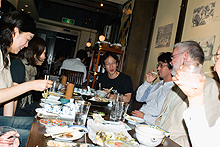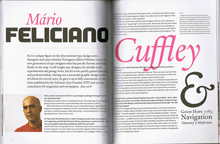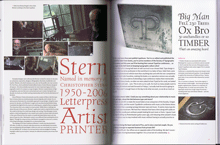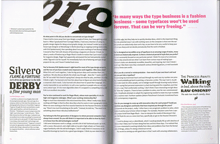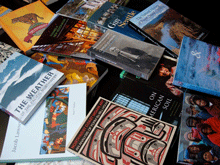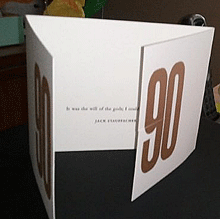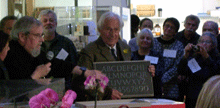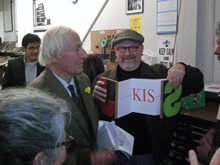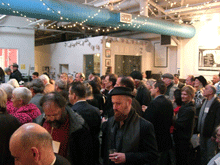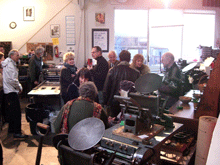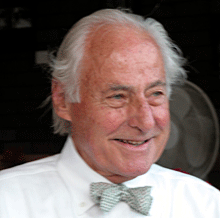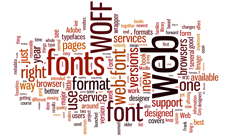Sunday, December 19, was Jack Stauffacher’s ninetieth birthday, and more than 150 of his friends came to celebrate it at the San Francisco Center for the Book. It was a gathering that illuminated both the breadth of Jack’s knowledge and his influence, through the wide variety of talented, creative people who showed up for the occasion in the midst of a ferociously stormy winter weekend. (“It always rains on my birthday,” Jack told me the day before. “It’s December – what can I expect? The clouds to open, trumpets to sound, and the sun to shine?”)
In talking about Jack, I can’t do better than quote Chuck Byrne, who wrote twelve years ago: “Jack Stauffacher describes himself as a printer. It is a somewhat deceptive term for us today. His use of the term connects him to a five-hundred-year tradition of the entrepreneur-publisher-designer-typographer-printer. Like the best who made up that custom, he possesses a love of type and printing and the ability to convey meaningful words and thought.” (“Jack Stauffacher, Printer,” 1998; cribbed in this case from the AIGA’s webpage from when they awarded Jack the AIGA medal.)
Chuck was one of the organizers of this birthday event, which brought together people from all parts of the Bay Area’s book, printing, arts, and design communities (and a few of us from farther away). It would be impossible to tell you all the people who were there, even if my memory for names hadn’t turned into a sieve. It was certainly a celebration – not just of Jack Stauffacher but of the interlocking creative communities that he has influenced, and continues to influence.
As Andrew Hoyem, of Arion Press, said a couple of days afterward, “I ran into people there that I hadn’t seen in years!”
It was a printer’s occasion. In the course of the party, Jack approved the inking on a hand-set letterpress keepsake that he had designed for the occasion, and many people ran off copies. There were a number of other keepsakes distributed, too (I brought one that I had commissioned from Jack leNoir and Maura Shapley at Day Moon Press in Seattle), but the most spectacular was the single big foldout artifact created by Pat Reagh, featuring Jack’s favorite typeface, Kis.
Several of Jack’s friends, and his two daughters, spoke briefly, and Chuck Byrne unveiled the hand-carved alphabet in slate that Chris Stinehour had made for Jack.
When Jack himself took the microphone, he spoke of the ongoing conversation, of how he delights in asking deep questions of everyone he meets, finding out about new things and gaining new understanding. And he urged us to carry this conversation forward – then he put down the mike to let us get on with it.
After all, this was just a birthday party, a punctuation point in a long discourse that’s not done. At 90, Jack may have slowed down a bit – all right, he no longer plays bicycle polo – but he’s still a vigorous voice for excellence, intellectual curiosity, and attention to our cultural history. And he’s intensely interested in what we have to say.
[Photos: (top) keepsake that Day Moon Press created for me for the occasion, designed by Jack leNoir and printed by Maura Shapley; (2nd from top) Jack Stauffacher holding the stone plaque hand-carved by Chris Stinehour; (3rd from top) Jack and Patrick Reagh, holding up Pat’s Kis keepsake; (4th from top) the milling throng; (bottom) milling around a couple of the hand presses at the San Francisco Center for the Book.]
Update: Chuck Byrne has posted three pages of photos taken by him and Dennis Letbetter at the event. For your convenience and amusement – no captions!
Categorized as books, culture, events, printing |

